
Artist, sculptor, photographer. Truth teller. Liar. What to call Thomas Demand, the Munich-born artist, who spoke just over a month ago at the University of Pennsylvania, sponsored by Penn Design ?
Demand, whose work Roberta and I first saw at the 1999 Carnegie International in Pittsburgh, and more recently, in the spring, at 303 Gallery in New York (see post) performs a neat trick–creating models based on accurate photographs–and then photographing the models.
Here are some of the things he said that I found interesting:
He tries to print his photos at the same size as the model that he built. In other words, the prints are nearly life-size.
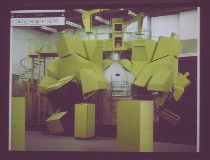 Some of his photos are so big that they require multiple panels of gigantic photo paper.
Some of his photos are so big that they require multiple panels of gigantic photo paper.
“Space Simulator,” (left), is a photo of a paper model of a training module that simulates an outer space experience for astronauts. It is so large, it took three panels of photo paper. (Most of the images in this post are not only shrunk down to nothing, which is a given, but they are photos taken of Demand’s slide lecture, so the large photos are reduced to computer images then projected by him and rephotographed by me. I felt that, in the interest of truth, I needed to share this just in case it wasn’t obvious.)
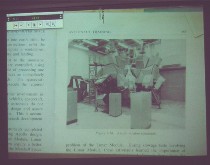 Demand’s model was based on a photo in a NASA book (right)— a 3-D model based on a 2-D representation of the original, which was something that simulated a real experience.
Demand’s model was based on a photo in a NASA book (right)— a 3-D model based on a 2-D representation of the original, which was something that simulated a real experience.
When he’s done creating the photographs, Demand destroys the paper model. I couldn’t help but wonder if, besides the practicality of saving space, he’s destroying the truth about his lie.
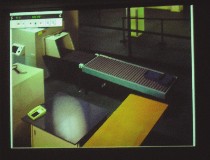 In a model he made of an airport departure gate with its conveyer belt for examining carry-on luggage, Demand said he was interested in making something that everyone is familiar with to the point of never even thinking of it as worthy of being in an art work. “The Gate” (left) is a generic pass-through, with no people and no trace of use. “Photos mediate our experiences,” said Demand.
In a model he made of an airport departure gate with its conveyer belt for examining carry-on luggage, Demand said he was interested in making something that everyone is familiar with to the point of never even thinking of it as worthy of being in an art work. “The Gate” (left) is a generic pass-through, with no people and no trace of use. “Photos mediate our experiences,” said Demand.
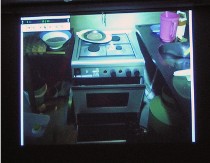 “The Kitchen” (right) is a recreation of Saddam Hussein’s hide-out kitchen, as photographed by a soldier and printed in newspapers around the world. Press photographers, said Demand, have been replaced by people who are involved in an event taking their own pictures. In “Clearing,” a sylvan scene (top image) made with 280,000 leaves cut out of paper, Demand captures a romantic moment, except in this one, he allows the facture to show.
“The Kitchen” (right) is a recreation of Saddam Hussein’s hide-out kitchen, as photographed by a soldier and printed in newspapers around the world. Press photographers, said Demand, have been replaced by people who are involved in an event taking their own pictures. In “Clearing,” a sylvan scene (top image) made with 280,000 leaves cut out of paper, Demand captures a romantic moment, except in this one, he allows the facture to show.
Demand also uses video in his plays on reality.
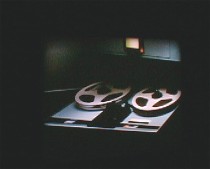 “Spinning Plates,” a 52-second reconstruction of a famous Lumiere Brothers film, loops 3 seconds of plates spinning so they seem to spin for a surprising length of time. Only common sense recognizes the lie, not your eyes. “Recorder” (left video still) records what appears to be an old eight-track tape recorder, its reels appearing to spin music. But Demand made the so-called tape recorder out of paper, and he sampled and looped the music from a Beach Boys recording to create a techno music sound that appears to come from the non-tape recorder.
“Spinning Plates,” a 52-second reconstruction of a famous Lumiere Brothers film, loops 3 seconds of plates spinning so they seem to spin for a surprising length of time. Only common sense recognizes the lie, not your eyes. “Recorder” (left video still) records what appears to be an old eight-track tape recorder, its reels appearing to spin music. But Demand made the so-called tape recorder out of paper, and he sampled and looped the music from a Beach Boys recording to create a techno music sound that appears to come from the non-tape recorder.
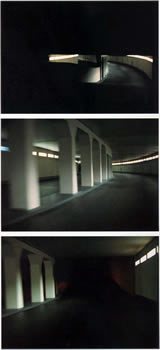 Some of his work has a dark side. In “Tunnel” (right video stills) his animation is of the tunnel in which Lady Diana died, selected because it’s one of the “things we all know about, but not via first-hand experience.” Demand rebuilt the tunnel and you know you’ve seen it before, just like you knew you had seen the airport gate. I had to leave early, but Roberta stayed the course, and mentioned to me that he also made a piece based on press photos of the hallway where serial killer Jeffrey Dahmer lived.
Some of his work has a dark side. In “Tunnel” (right video stills) his animation is of the tunnel in which Lady Diana died, selected because it’s one of the “things we all know about, but not via first-hand experience.” Demand rebuilt the tunnel and you know you’ve seen it before, just like you knew you had seen the airport gate. I had to leave early, but Roberta stayed the course, and mentioned to me that he also made a piece based on press photos of the hallway where serial killer Jeffrey Dahmer lived.
Demand was also inspired by the tv set built for a press conference for when the Berlin Wall came down. He thought it looked like a Renaissance picture, but then he wanted it to be less political, more generic, so he went to a popular, 40-years in duration tv quiz show, “Was bin ich?,” or Who am I? for his piece, “Studio.”
He digressed here and went into his fascination with the Florida vote recount in 2000. He was intrigued by people counting pieces of paper. “It was all about paper,” he said. “It was also an event which will not go away.”
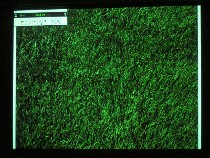 A few other subjects he further fictionalized–Jackson Pollack‘s studio, based on a photo in Life Magazine; “Lawn” (left) thoroughly banal and created with hand-cut pieces of grass; the post office in the village where he grew up, with its Bauhaus detail; a changing room, which, without people, made me think of Nazi concentration camps; an airplane on the tarmac, based on standard news photograph of someone arriving and disembarking, but no people are in Demand’s recreation. Think of Gerald Ford tumbling out of Air Force One, and then erase him and everyone else.
A few other subjects he further fictionalized–Jackson Pollack‘s studio, based on a photo in Life Magazine; “Lawn” (left) thoroughly banal and created with hand-cut pieces of grass; the post office in the village where he grew up, with its Bauhaus detail; a changing room, which, without people, made me think of Nazi concentration camps; an airplane on the tarmac, based on standard news photograph of someone arriving and disembarking, but no people are in Demand’s recreation. Think of Gerald Ford tumbling out of Air Force One, and then erase him and everyone else.
In a November New Yorker, Malcolm Gladwell wrote on photography’s failed promise to tell the truth vis a vis surveillance and mammograms (article here).
The more time we spend on mediated images, the less we can trust our “knowledge” partially because our expectations of accuracy and technological perfection are out of line. This theme came across loud and clear in the most recent Carnegie International, especially in the installations by Harun Farocki (see post), but also in the work of Kutlug Ataman and Paul Chan.
But even if you get off your computer, put away your digital camera, get your nose away from the newspaper and the tv screen and have a direct experience, there’s no guarantee that you’ll get it right. I’m thinking here of the refs at the football game who refer to the video playbacks, sometimes, to clarify what happened.
There’s no getting around the fact that clarity and truth are not a given.









